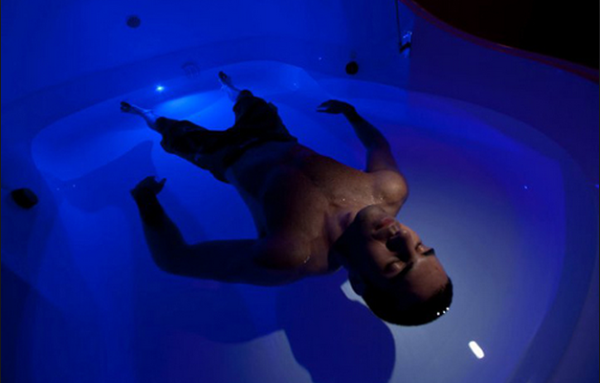
When I’m in the middle of a dream / Stay in bed, float upstream . . .
(“I’m Only Sleeping,” The Beatles)
If you caught July’s installment of Floativation, you’ll recall that it kicked off with a Beatles lyric about “floating downstream” from “Tomorrow Never Knows.” “I’m Only Sleeping” (excerpted above) extols the comparable pleasures of “floating upstream,” also in the figurative sense. Examined side by side, the two Beatles songs (both recorded in April of 1966) reveal a degree of thematic similarity: that of escape, both from physical activity and from the overloaded conscious mind.
Both songs were initiated by John Lennon, who had adopted a very sedentary lifestyle when at his English home, away from the madness of touring. One lyric in “Sleeping” observes the constant movement of a society running everywhere at such a speed / ’til they find there’s no need. Lennon’s endorsement of slowing down the pace of life has only become more applicable in the decades since. This is one of the primary reasons to consider the benefits of a float tank like the ones I’ve been using for months now at local sanctuary Float Alchemy. And the release found in floating is what Lennon had in mind with both songs . . . the reason why they’re mentioned here.

Before float tanks came along and presented Lennon with a quantum leap forward in promoting total, drug-free relaxation via sensory deprivation, the homebound Beatle would settle for limiting activity mostly to mental pursuits such as reading and writing, and sleeping as much as possible. Fellow Beatle Paul McCartney would typically wake Lennon in the early afternoons after traveling to his home to commence songwriting sessions like the one in March 1966 that yielded “I’m Only Sleeping.”
Sleeping, even a catnap, has numerous known benefits. But a prolonged, conscious experience of the brain’s serene theta state, which occurs as sleep first descends, is usually not one of them. In a float tank, a sustained theta-wave experience is indeed quite possible, allowing one to hover on the blissful brink of sleep without drifting off. You can relax your tired frame on a mattress or sofa, but only in a float tank can every muscle relax simultaneously and the blood circulate unimpeded throughout the entire body.

The low-gravity environment in the tank allows the spine to stretch as much as an inch, and permits relief for sufferers of chronic pain. Sleep is a healing and essential respite from mental and physical activity, but a session in a float tank actually prompts the brain to release a flood of endorphins in response to the deep relaxation that occurs. These neurotransmitters can help relieve pain, decrease anxiety or depression, and enhance mood. Floating also decreases chronic muscle tension and creates greater awareness of less noticeable areas of tension and imbalances. In fact, this was one of the unanticipated benefits I experienced. More on that in just a bit.
As I’ve documented in this series (available at boropulse.com/floativation, I started floating to find out what I’d gain. In addition to receiving core benefits like those mentioned above, I was able to customize the journey for my own personal purposes. I was exploring the possibility of womb trauma, wondering whether my own difficulties with physical tension and overall unease could be traced back to a stressful womb environment. I had become curious about how the float tank might be suitable as a specific therapeutic tool addressing my own experience gestating in my mom’s fluid-deficient womb. I haven’t fully answered that question, and neither have researchers . . . yet.
In an email to Dr. Justin Feinstein, a prominent neuropsychologist researching the benefits of floating, I asked if he thought the tank was capable of providing compensation for anything I had lacked in the nine months prior to my birth. If a peaceful womb experience produced a calmer human, might a peaceful tank experience show the brain how to access more calm?
“These are great questions,” Dr. Feinstein wrote, “and I’ve pondered for quite some time the implications of floatation on early life adversity, including that experienced within the womb. Unfortunately there’s no data to speak to this directly, but I do think you are onto something.”
He reported that he’d heard personal anecdotes about the potential benefits patients were seeing relating to early traumatic experiences. “This topic definitely needs to be systematically investigated,” he said in conclusion, wishing me well on my own investigation.
So, the matter is a work in progress, exactly like me. Back in March, equipped with a custom-made CD of womb sounds and relevant scriptures, I had embarked on a float that I believed might provide a “surrogate” womb experience calmer than the one I’m pretty sure I had. I’ll be the first to admit the whole idea is a bit off the beaten path, but the mind is capable of surprising things, especially when in the calm state that a float produces.
The slowed-down theta brain waves that can accompany the extreme relaxation of a float make it possible for the rational mind to loosen its usual tight grasp. This, I later reckoned, must be what allowed my mind to spontaneously visualize gauzy silhouettes of two figures alongside me at about waist level, “seen” from an inside-looking-out perspective. A doctor and nurse at a delivery table? Well, seemingly so. The image didn’t last long, but it suggested that my subconscious mind was buying into this back-to-the-womb thing. Interesting.
In my spiritually receptive theta-wave state, I was meaningfully affirmed by scriptures included on my soundtrack CD, such as before I formed you in the womb I knew you (Jeremiah 1:5) and for you created my inmost being; you knit me together in my mother’s womb (Psalms 139:13). It was a memorable and particularly pleasant tank experience, singular among the dozen or so sessions I’d done to date.
Do I still have more progress to pursue in overcoming longstanding tension and anxiety? Sure. But in reviewing the past 11 months since I began my floating adventure at Float Alchemy, I’ve gotten some perspective on the process that has unfolded. It’s been a therapeutic as well as organic one, leading to both hoped-for and unanticipated benefits.
For example: After several floats, I’d noticed constriction in my hips and groin area I’d previously only been vaguely aware of at best (as mentioned above, the mental clarity of the tank experience calls attention to such things). While I always found the tank to be stress-relieving and refreshing, I often found it a challenge to fully relax my legs at the hip joints. After months of floating, I learned that Float Alchemy owner Amy Grimes’ masseuse expertise included a technique called Active Isolated Stretching.
It only took a few sessions with Amy to begin loosening long-carried tension and expanding my range of motion. My most recent float, a few weeks ago, offered proof of the results I’d gotten: I no longer had difficulty letting my midsection relax entirely, which now easily surrendered along with the rest of my body as I lay atop the saline-supported water. This is a testament not only to the host of complementary services available from the gentle and knowledgeable folks at Float Alchemy, but also to the potential for ongoing progress that floating and deep relaxation make possible.
Sounding good to anyone yet? Float Alchemy awaits, Murfreesboro. Tell ’em John Lennon sent you.













